Teena Agrawal*
Banasthali University, Rajasthan, India
Corresponding Author:
Teena Agrawal
Banasthali University, Rajasthan, India
Tel: +91-9680724243
E-mail: tagrawal02@gmail.com
Received date: July 11, 2017; Accepted date: August 07, 2017; Published date: August 11, 2017
Citation: Agrawal T. Ethnobotanical Investigation of the Silisarh Lake Area of the Alwar District of Rajasthan. Br J Res 2017, 4(3):18. doi: 10.21767/2394-3718.100018
Copyright: © 2017 Agrawal T. This is an open-access article distributed under the terms of the Creative Commons Attribution License, which permits unrestricted use, distribution, and reproduction in any medium, provided the original author and source are credited.
Keywords
Ethnobotany; Conservation; Planned utilization; Medicinally important
Introduction
India is rich sources of the biodiversity; all the states of the India are the rich sources of the biodiversity, from north-south, east to west, and rich sources of the biodiversity can be seen. To protect the biodiversity in India biodiversity board has been constructed, that is the national biodiversity board [1]. National biodiversity board has appointed the national biodiversity policy and law to deal the current and emerging aspects of the biodiversity rules and the issues.
India has the remarkable source of the biodiversity, only after Africa India is the second richest sources of the biodiversity; a number of the hot spot of the biodiversity has been assigned in India.
Hot spot is the region which is concerned with the endemism and the 70% of the vegetation has been lost form the area (Figure 1). These are follows:
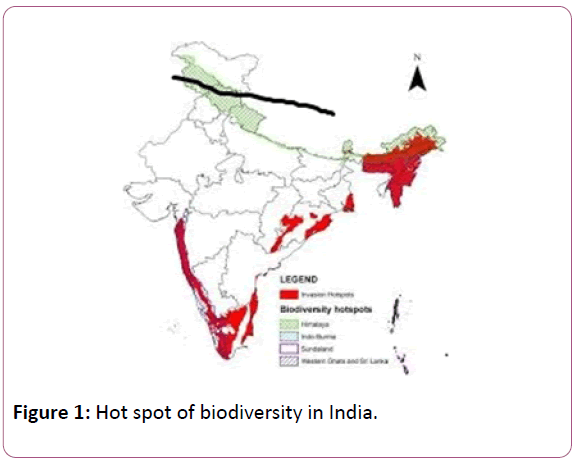
Figure 1: Hot spot of biodiversity in India.
• Western Ghats
• The eastern Himalayas
• Sunder ban
• Far East area
India has also been divided in the different kind of the bio geographic area; bio-geographic region is the distribution of the species in the particular area, in a particular climate [2]. Environmental studies) (Figure 2).
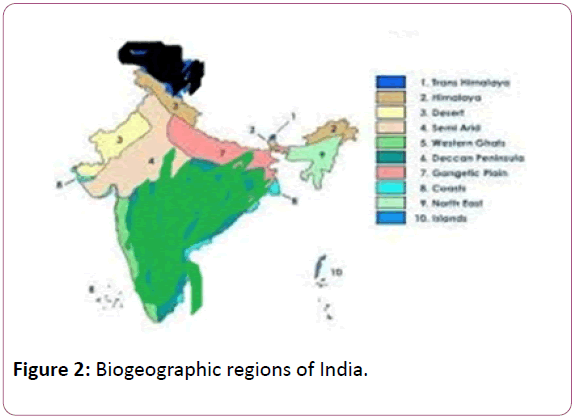
Figure 2: Biogeographic regions of India.
Some of the bio geographic region of the India is enlisted as.
• Trans Himalayan region
• Himalayan zone
• Desert zone
• Semiarid zone
• Western Ghats
• Deccan plateau
• Gangetic plains
• North eastern zone
• Coastal area
• Islands
The biodiversity of the India is threatened by a number of the factors, among them the growing human population and the climate change & anthropogenic factors are the major reasons which are responsible for the degradation of the biodiversity of the India [3].
In India and the other part of the world also the forest and deep oceanic islands and the other regions are the sources of the biodiversity, from the civilization of the human beings these plants and the animals are the richest sources of the all kinds of the needs of the humans (in early domestication of the plants). The plants were utilized as the sources of the food, medicines and the other things. Today 99% of the commercial and economically important plants are the resultant of the domestication of the plants by different means by the different society in the different ages of the development of the human society from 3000BC to today era [4].
In India the all states have the tremendous kind of the biodiversity. In India Rajasthan is the area which is although is in nature arid and semiarid of nature but many of the places in Rajasthan also have the good biodiversity like in the hilly areas of the Mount abu and the other regions of the arawalli hills [5].
In this case we try to elucidate the ethno botanical investigation of the one of the area of the Alwar district of Rajasthan.
Alwar is the city and it is situated in between the Jaipur and the Delhi region. Historically Alwar is famous for the many kinds of the monuments and the forts. The Balkila fort region is famous for the famous king and there emperor ship, the area of the Ajabgrah and the Bhangrah are famous for the Haunted places in India.
A long hillock of the Arawalli hill is the beauty of the Alwar city. The waving hills of the Arawali regions are the rich sources of the many kinds of the vegetation. Although the basic nature of the vegetation is the arid and the semiarid types, however in the rainy seasons the tremendous kinds of the vegetation can be seen. World famous Sariska tiger sanctuary is the reservoirs of the many kinds of the vegetation. A clear stratification can be seen during the whole whether, in this case a long belt of the tree, shrubs and herbs are the point of interest [6-20].
Rupareal River is the beauty of the city, it is the good examples of the lentic ecosystem, some of the aquatic vegetation and the aquatic animals can be seen over there. They are the examples of the rare taxonomic importance. From IUCN point of view they have been categorized in to the threatened and the endangered species.
In Alwar across whole of the city is crossed by the Arawali hills, the vegetation on the hills during the rainy seasons are of diverse kind. A number of the rare and the medicinally important vegetation can be seen on the Arawali hills [21-26].
In Arawali hills the dominant form Anogessus pendula and some other trees are in the dominant form, although stratification of the vegetation area is the can be seen in whole of the weather [26-30].
In that paper we are trying to analyze the Ethnobotanical investigation of the area of the Alwar district of the Rajasthan entitled as the silisarh area [31-40]. This area is very fertile and has a number of the vegetation in composition. There are a number of the tribes are living in the area who are utilizing the plants from the decades for the various purposes.
Material and Methods
Silisarh area is the 7-8 km area located far from the city. This lake area is located in the north eastern part of the city. This lake is constructed by the Maharajas Vinaysingh in 1845, the purpose of the lake was that during the rainy season whole of the lake was filled by the water and the whole city is supplied by the water from the lake. The area around the Silisarh lake is fertile and rich. It contains a number of the vegetation of the complex Taxonomic entity. The Ethnobotanical investigations are carried out to compare the indigenous knowledge about the uses of the medicinal plants for the treatment of the various kinds of the diseases.
Ethnobotanical investigation was collected from the native inhabitants, of the places, using the semi structures questionnaires, filed work was done for the documentation of the data, plants has been taken and collected, and photographed. However during the questioner the Kyoto protocols of the biodiversity conservation has been taken in to the consideration. The information was asked for the traditional knowledge of the plant part and the methods of their utilizations .Interviews were conducted in the local language [6,41-47].
Well we have visited the area during the 2009 and 2010, a significant change in the vegetation can be seen during the summers and the winters and rainy seasons .In rainy seasons the diversity of the plants are at the peaks (Figures 3-7).
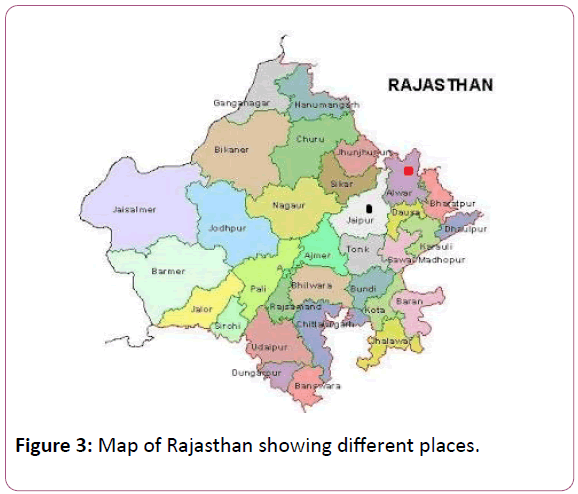
Figure 3: Map of Rajasthan showing different places.
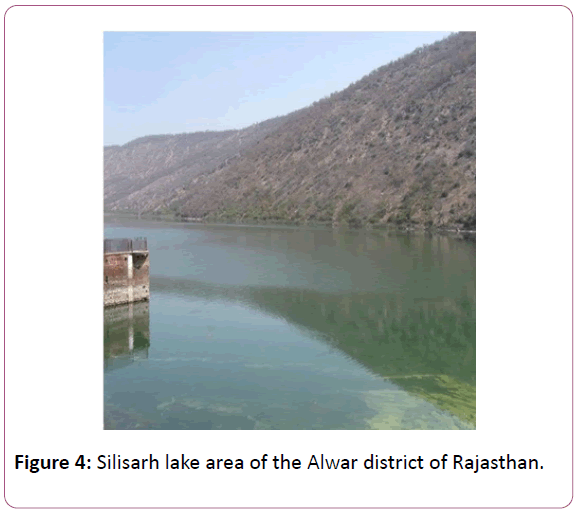
Figure 4: Silisarh lake area of the Alwar district of Rajasthan.
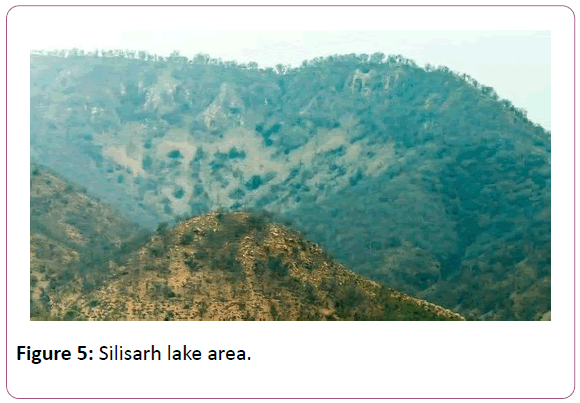
Figure 5: Silisarh lake area.
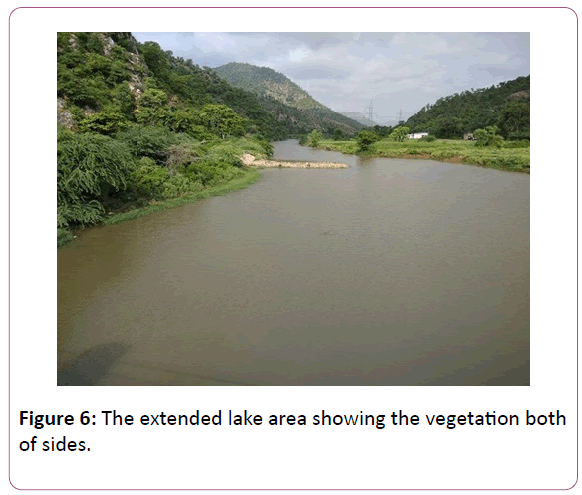
Figure 6: The extended lake area showing the vegetation both of sides.
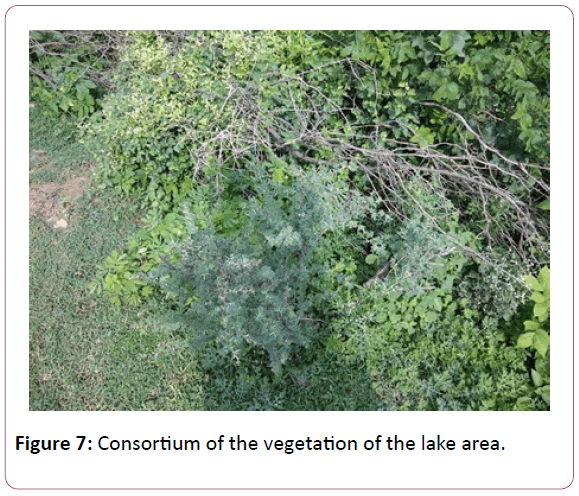
Figure 7: Consortium of the vegetation of the lake area.
Results and Discussion
A total of the 45 men, 40 women’s are interviewed for the utilization of the medicinal plants for the ethno botanical purposes [21-29,48]. The information was divided in to different groups (Table 1).
| S.no. |
Taxon |
Life forms |
Plant part used |
Family |
Way of utilization |
Purposes |
| 1 |
Achyranthes aspera |
Herbs |
Roots, stem, leaves & fruit |
Amaranthaceae |
Powdered form |
High fever and cold |
| 2 |
Achyrnathes argentia |
Herbs |
Roots, stem, leaves & fruit |
Amaranthaceae |
Power form |
Cold and in asthma |
| 3 |
Aconitum spp |
Herbs |
Roots & leaves |
Ranunculaceae |
Roots |
Joint pain, high fever |
| 4 |
Acorum spp |
Herbs |
Roots & leaves |
|
Paste and powder |
Digestive disorders |
| 5 |
Amaranthus spp |
Herbs |
Leaves & roots |
Amaranthaceae |
Powder form |
For eating purposes |
| 6 |
Atropa spp |
Herbs |
Leaves & roots |
Soalnaceae |
Powder form |
For respiratory purposes |
| 7 |
Berbaris spp |
shrubs |
Leaves & roots |
Berbiradaceae |
Power, paste form |
For respiratory purposes |
| 8 |
Calotropis procera |
Shrubs |
Leaves, roots & fruits |
Asclepediaceae |
Power and in rough form |
For different kinds of the bacterial infections |
| 9 |
Fragaria |
Herbs |
Leaves & roots |
|
|
Skin infections |
| 10 |
Justicia adhotoda |
Shrubs |
Roots, leaves & stem |
Acanthaceae |
Powder and in rough form |
Respiratory and skin infections |
| 11 |
Melia azadiratica |
Shrubs |
Fruits |
|
Pulp |
Skin disorders |
| 12 |
Ricinus communis |
Tree |
Leaves, roots & fruits |
Euphorbiaceae |
Power and in rough form |
Nervous disorders, respiratory disorders |
| 13 |
Verbascum spp |
Herb |
Leaves & stem |
Compositae |
In powder form and rough form |
For eating purposes |
| 14 |
Viola spp |
Herb |
Leaves |
|
|
For eating the leaves |
| 15 |
Withania somnifera |
Herb |
Leaves & roots |
Solanaceae |
In rough and powder form |
For respiratory purposes, |
| 16 |
Zizypus jujube |
Shrubs |
Roots & leaves |
Rhanmanaceae |
Leaves |
As a forage |
| 17 |
Abutilon indicum |
Shrubs |
Leaves & roots |
Malvaceae |
Leaves, fruit |
Alimnets disorders |
| 18 |
Abutilon asiaticum |
Shrubs |
Leaves & roots |
Malvaceae |
Leaves |
For digesting disorders |
| 19 |
Acacia arabica |
Tree |
Leaves, roots, stem & fruits |
Mimosaceae |
In different form |
For various purposes |
| 20 |
Acacia catechu |
Tree |
All parts of the plants |
Mimosaceae |
In different form |
For many purposes |
| 21 |
Achalypha indiaca |
Herbs |
Leaves |
Euphorbiaceae |
In powder form |
As a forage and for digestive disorders. |
| 22 |
Acalypha paniculata |
Herbs |
Leaves |
Euphorbiaceae |
In paste form, |
Antibacterial activities |
| 23 |
Acanthospermm |
Herbs |
Leaves, fruit & stem |
Achanthaceae |
Powder and paste form |
Antibacterial form |
| 24 |
Ageratum conjoides |
Herbs |
Leaves, fruit & roots |
Compositae |
Powder form ,in paste form |
In intestine problem |
| 25 |
Acanthus licifoia |
Herbs |
Leaves & roots |
Achanthaceae |
Different form |
For eating purposes |
| 26 |
Achillea millifoium |
Herbs |
Whole parts |
Asteraceae |
Powder form |
For various purposes |
Table 1: Enlistment of the various plants of the silisarh lake regions for the Ethnobotanical purposes.
• 31-40 years
• 45-60 years
• 60 -70 years
Conclusion
This study is based on the plant based medicines or the utilization of their plants for the various kinds of the purposes. The present paper summarizes the data on the 26 plants. The majority of the plants are utilized for the purposes of the treatments of the bacterial infection caused by the different kinds of the bacteria during the rainy seasons.
These kinds of the studies are very useful for the conservation of the flora of any regions. Since the communities are living in the area from the long time and they are familiar with the utilization of the plants of any regions. These days the tribal regions and the tribal area are disappearing with the great speed so that the knowledge with them also disappearing, so it is very urgent needs to conserve the plants of these area for the betterment of the society and the regions (Biodiversity conservation).
References
- Myers N (1988) The Environmentalist. 8: 187-208.
- Myers N (1990) The Environmentalist. 10: 243-256.
- Kevin JG (2000) Global patterns in biodiversity. Nature 405: 220-227.
- Binu S, Nayar T, Pushpangadan P (1992) An Outline of Ethnobotanical Research in India. Journal of Economic Taxonomy and Botany 10: 405-428.
- Choudhary K, Singh M, Pillai U (2008) Ethnobotanical Survey of Rajasthan- An Update. Am Citeseer 38-45.
- Ugulu I, Baslar S, Yorek N, Dogan Y (2009) The investigation and Quantitative Ethnobotanical Evaluation of medicinal plants used around Izmir Province, Turkey. Journal of Medicinal plants Research 3: 345-367.
- Vitalini S, Iriti M, Puricelli C, Ciuchi D, Segale A, et al. (2012) Traditional knowledge on Medicinal and Food Plants used in Val San Giacomo (Sondrio, Italy). An alpine Ethnobotanical Study 145: 517-529.
- Wondimu T, Asfaw Z, Kelbessa E (2007) Ethnobotanical Study of medicinal plants around Dheeraa town, Arsi Zone. Ethiopia J Ethnopharm 112: 152-161.
- Srithi K, Balslevb H, Wang P, Srisangac P, Trisonthia C, et al. (2009) Medicinal plant knowledge and its erosion among the Mien (Yao) in Northern Thailand. J Ethnopharm 123: 335-342.
- Passalacqua NG, Guarrera PM, De Fine G (2007) Contribution to the knowledge of the folk plant medicine in Calabria region (Southern Italy). Fitoterapia 78: 52-68.
- Rashid A, Swati MF, Sher H, Al-Yemeni (2011) Phytoecological Valuation with detail floristic appraisal of the vegetation around Malam Jabba, Swat, Pakistan. Asian Pacific J Tropic 1: 461-467.
- Schulz V, Hänsel R, Tyler VE (2001) Rational Phytotherapy. A physician’s guide to herbal medicine Berlin. Rational Phytotherapy.
- Tardio J, Pardo-de-Santayana M (2008) Cultural importance indices: A comparative Analysis based on the useful wild plants of Southern Cantabria (Northern Spain). Economic Botany 62: 24-39.
- Shinwari ZK (2010) Medicinal plants research in Pakistan. J Med Plants Res 4: 161-176.
- Hamayun M (2007) Traditional uses of some medicinal plants of Swat valley, Pakistan. Pak J Bot 6: 636-641.
- Ibrar M, Hussain F, Sultan A (2007) Ethnobotanical Studies on plant resources of Ranyal Hills, District Shangla, Pakistan. Pak J Bot 2: 329-337.
- Jan G, Khan MA, Farhatullah Jan, Ahmad M, Jan M, et al. (2011) Ethnobotanical studies on some useful plants of Dir Kohistan valleys, Pakistan. Pak J Bot 4: 1849-1852.
- Guarrera PM, Forti G, Marignoli S (2005) Ethnobotanical and Ethnomedicinal uses of plants in the district of Acquapendente (Latium, Central Italy). J Ethnopharmacol 96: 429-444.
- Ben?’tez G, Gonza lez-T, Molero-Mesa J(2010) Pharmaceutical Ethno-Botany in the western part of Granada province (SouthernSpain): ethnophar-macological synthesis. J Ethnopharm 129: 87-105.
- Anonymous (2010) District Swat: socioeconomic Baseline and Displacement Impact Khyber Pakhthunkhwa: Centre for Public Policy Research.
- Anonymous (2009) Preliminary Damage and Needs Assessment in North West Frontier Province and Federally Administered Tribal Areas of Pakistan.
- Anonymous (2000) Biodiversity Action Plan for Pakistan A Framework for Conservation of our Natural wealth. 2000, Pakistan: Government of Pakistan, World Wide Fund for Nature, Pakistan and International Union for Conservation of Nature and Natural Resources, Pakistan. Printed by Imprint (Pvt) Ltd., Rawalpindi Cantt.
- Anonymous (2001) NWFP Forestry Sector Project (FSP), Peshawar: Operational Plan (OP) for Madyan Resources Management Sub-Unit Kalam Forest Division at Madyan. Forestry, Fisheries and Wildlife Department, NWFP.
- Ahmad M, Khan MA, Zafar M, Hasan A, Sultana S, et al. (2009)Chemotaxonomic Authentication of Herbal Drug Chamomile. Asian J Chem 21: 3395-3410.
- Balemie K, Kelbessa E, Asfaw Z (2004) Indigenous medicinal plants utilization, management and threats in Fentale area, Eastern Shewa. Ethiopia Ethiopian J Biolog Sci 3: 37-58.
- Blanco E, Macia MJ, Morales R (1999) Medicinal and veterinary plants of El Caurel (Galicia, northwest Spain). J Ethnopharm65: 113-124.
- Cornara L, La Rocca A, Marsili S, Mariotti MG (2009) Traditional uses of plants in the Eastern Riviera (Liguria, Italy). J Ethnopharm 125: 16-30.
- Giday M, Asfaw Z, Elmqvist T, Woldu Z (2003): An Ethnobotanical study of medicinal plants used by the Zay people in Ethiopia. J Ethnopharm 85: 43-52.
- Akhtar N, Rashid A, Murad W, Bergmeier E (2013) Diversity and use of ethno-medicinal plants in the region of Swat. North Pakistan J Ethnobiol Ethnomed 9: 25-10.
- Ahmed S (2012) Pakistan’s economy hit hard by war on terror Islamabad - Pakistan: Central Asia.
- Adnan M, Begum S, Latif A, Tareen AM, Lee LJ, et al. (2012) Medicinal plants and their uses in selected temperate zones of Pakistani Hindukush- Himalaya. J Med Plants Res. 6: 4113-4127.
- Abebe D, Ayehu A (1993) Medicinal Plants and Enigmatic Health Practices of Northern Ethiopia. Addis Ababa, Ethiopia.
- Adnan M, Ullah I, Tariq A, Murad W, Azizullah A, et al. (2014) Ethnomedicine use in the war affected region of Northwest Pakistan. J Ethnobiol Ethnomed 10: 16.
- Abbasi AM, Khan MA, Ahmad M, Zafar M (2012) Medicinal Plant Biodiversity of Lesser Himalayas-Pakistan Springer USA.
- Abe R, Ohtani K (2013) An Ethnobotanical study of medicinal plants and traditional therapies on BatanIsland, the Philippines. J Ethnopharm 145: 554-565.
- Abbasi AM, Khan MA, Khan N, Shah MH (2013) Ethnobotanical survey of medicinally important wild edible fruits species used by tribal communities of Lesser Himalayas-Pakistan. J Ethnopharm. 148: 528-536.
- Abbasi AM, Khan MA, Ahmad M, Zafar M, Sarwat J, et al. (2010) Ethnopharmacological application of medicinal plants to cure skin diseases and in folk cosmetics among the tribal communities of North-West Frontier Province. Pakistan J Ethnopharm 128: 322-335.
- Hali SM (2012)Economic Terrorism The Nation Islamabad Pakistan: Jang Group of News Papers.
- Khan HA (1995) Working plan for protected forests of Bahrain Tehsil (Swat District), 1995-96 to 2009-10. 1995, Peshawar Pakistan: NWFP Forest Department.
- Martin GJ (1995) Ethnobotany a people and plant conservation manual. New York Chapman and Hall.
- Mulk KS, Page S, Ahmad H, Shaheen H, Ullah Z, et al.(2013) Medicinal Flora and Ethnoecological Knowledge in the Naran Valley, Western Himalaya, Pakistan. J Ethnobiol Ethnomed. 9: 4-10.
- Mitherman LC, Janisse J, Mathur A (2005) The use of folk remedies among children in an urban black community: remedies for fever, colic, and teething. Pediatrics 3: 297-304.
- Nasir E, Ali SI (1970-2002) Flora of Pakistan National Herbarium, NARC, Islamabad and Department of Botany, University of Karachi, Karachi. Fasc 41: 1-207.
- Ragunathan M, Solomon M (2009) The study of spiritual remedies in orthodox rural churches and traditional medicinal practice in Gondar Zuria district Northwestern Ethiopia Pharmacognosy 1: 178-183.
- Savikin K, Zdunic G, Menkovic N, Zivkovic J, Bigovic D et al. (2013) Ethnobotanical study on traditional use of medicinal plants in South- Western Serbia, Zlatibor district. J Ethnopharm 146: 803-810.
- Scherrer AM, Motti R, Weckerle CS (2005) Traditional plant use in the areas of Monte Vesoleand Ascea, Cilento National Park (Campania, Southern Italy). J Ethnopharm 97: 129-143.
- Sheikh K, Ahmad T, Khan MA (2002) Use, exploitation and prospects for conservation people and plant biodiversity of Naltar Valley, Northwestern Karakorums, Pakistan. BiodiversConserv 11: 715-742.
- Biological Diversity Act 2002 and establishment of National Biodiversity Authority, Chennai. Ministry of Environment and Forests.








